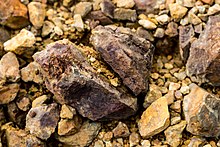Mamut Mine
 Landscape of the abandoned mine. | |
| Location | |
|---|---|
 Mamut Mine Location of the mine in Malaysia. | |
| Location | Ranau District |
| State | Sabah |
| Country | Malaysia |
| Coordinates | 6°1′37.7″N 116°39′21.0″E / 6.027139°N 116.655833°ECoordinates: 6°1′37.7″N 116°39′21.0″E / 6.027139°N 116.655833°E |
| Production | |
| Products | Copper, with some gold and silver[1] |
| Production | 2.1 million tonnes of concentrates containing 520,000 copper, 39 tonnes of gold and 255 tonnes of silver mined from 1975 until its closure in 1999[1] |
| Type | Open-pit mine |
| Greatest depth | 500 metres |
| History | |
| Opened | 1975 |
| Closed | 1999 |
| Owner | |
| Company | Mamut Copper Mining Sdn Bhd |
Mamut Mine (Malay: Lombong Mamut) is an abandoned open-pit quarry mine located in the Ranau District of Sabah, Malaysia where from 1975 to 1999 various minerals primarily copper including some gold and silver were mined. The mine is known as Malaysia's only copper mine. It came to public attention due to major environmental harm it caused.[2][3]
Geology[]

The source rock for the mine is adamellite porphyry and the plutons were implaced[check spelling] hypabysally into Palaeogene turbiditic rocks in the Trusmadi Formation and Early Cretaceous ophiolite. The average age of porphyry stocks is 9 mega-annum (Late Miocene) with total reserves of deposit about 179 Mt Cu grade.[4] The mine porphyry copper deposite is associated with tertiary granitoid intrusions with mineral reserves of 77 million tonnes of ore, an average grade of 0.608% copper and recoverable amounts of gold and silver.[1]
History[]
Established through a consortium between Japanese and Malaysian companies,[5][6] the mine began its production in 1975 and produced a total 21,613.8 tonnes (21,613,800 kg) minerals valued at $11.5 million which was exported overseas.[7] Towards the end of 1991, the number of workers in the mine increased to 1,191 from only 100 with 99% of those employed are Malaysian.[8] It is estimated that together with their families, the total number of people dependent their livelihood on the mine is over 10,000.[9] The first production of copper mine also showed that Malaysia was rich in natural resources that contributed to the country's output with most copper, silver and gold are produced in East Malaysia.[7][10] Minerals gathered from the mine was trucked to Kota Belud District before being shipped to Japan for refining.[4]
Since its closure and subsequent abandonment, waters have filled the mine which is toxic to consumption due to its highly acidic nature. In 2001, the government of Sabah through Chief Minister Chong Kah Kiat trying to attract the interest among investors to develop the abandoned mine area for tourism attraction which is ideal for resort development with the highland weather, interesting topography and scenic view of Mount Kinabalu despite no further deal are being realised.[11] Further in 2016, Sabah Deputy Chief Minister Joseph Pairin Kitingan said the local authorities were looking at the possibility of treating the 20.6 million cubic metre of acidic water at the mine pit to overcome water shortage in Sabah caused by drought although this proposal later were considered by local geologist as unfeasible and costly since even if the water could be treated with acid mine drainage (AMD) method to neutralise its acidity, other minerals and heavy metals are still present in the water that made it unfit for human consumption and need more cost to clean the water.[12]
See also[]
References[]
- ^ a b c Amarjit Kaur; Ian Metcalfe (12 February 1999). The Shaping of Malaysia. Palgrave Macmillan UK. p. 30. ISBN 978-1-349-27079-8.
- ^ "Overview". Malaysian Minerals. Archived from the original on 28 August 2019. Retrieved 28 August 2019.
Malaysia no longer produces copper and silver (as a byproduct of copper mining) because the country's only copper mine the Mamut Mine near Ranau, Sabah, ceased operations in October 1999.
- ^ Marcus Jopony; Felix Tongkul (2009). "Acid Mine Drainages at Mamut Copper Mine, Sabah, Malaysia" (PDF). Borneo Science. S2CID 8490329. Archived from the original (PDF) on 28 August 2019. Retrieved 28 March 2019 – via Semantic Scholar.
- ^ a b C. S. Hutchison (7 November 2005). Geology of North-West Borneo: Sarawak, Brunei and Sabah. Elsevier. p. 374. ISBN 978-0-444-51998-6.
- ^ Hideki Imai (1 January 1978). Geological Studies of the Mineral Deposits in Japan and East Asia. University of Tokyo Press. ISBN 978-0-86008-208-8.
- ^ Shunsō Ishihara; Sukune Takenouchi (1980). Granitic magmatism and related mineralization. Society of Mining Geologists of Japan.
- ^ a b "The First Production Of The Copper Mine In Mamut, Sabah". National Archives of Malaysia. 8 May 1975. Archived from the original on 28 August 2019. Retrieved 28 August 2019.
- ^ Minerals Yearbook. The Bureau. 1993. ISBN 978-0-16-041931-7.
- ^ "Sectoral Development [Mining]". Borneo Trade. Retrieved 28 August 2019.
- ^ The Japan Environmental Council (6 December 2012). The State of the Environment in Asia: 2002/2003. Springer Science & Business Media. p. 67. ISBN 978-4-431-67945-5.
- ^ "Investors urged to develop abandoned Mamut Copper Mine". Chief Minister Department (Press release). Government of Sabah. 9 August 2001. Archived from the original on 28 August 2019. Retrieved 28 August 2019.
- ^ "Contaminated water in mining pool too costly to treat". Free Malaysia Today. 31 March 2016. Archived from the original on 28 August 2019. Retrieved 28 August 2019.
External links[]
 Media related to Mamut Mine at Wikimedia Commons
Media related to Mamut Mine at Wikimedia Commons
- Mines in Sabah
- Copper mines in Malaysia
